Successfully meeting the challenges of today's learning technology landscape requires a more reflective, more critical perspective.
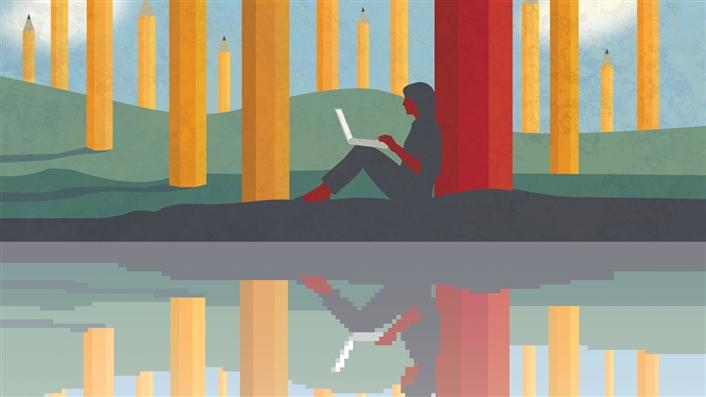
One of the reasons I love what I do is that I have always been interested in how we, as human beings, relate to the world around us and, in particular, how we relate to technology. For me, there is no better context than education and lifelong learning to explore how that relationship is evolving as digital technology becomes more pervasive in our lives.
Working in learning technology, or education technology ("edtech"), is changing as our understanding of technology develops. We have become more aware not only of the potential of technological innovation but also of what is needed to scale up this innovation from use in small-scale pilots or single classrooms to applications for all learners. Scaling up requires not only infrastructure and technical capabilities but also skilled staff and robust policies. Most importantly, we need to keep questioning whether learning technology really delivers benefits for all students. We know that technology has huge potential, but we now have decades of research and practice to build on as we move our professional practice beyond advocacy and toward a more reflective, more critical perspective—a perspective that, I hope, will empower us to tackle some of the complex questions around ethics, inclusion, equality, and privacy.
In this article, I wish to combine both a personal perspective and one informed by my professional position. I wish to share my personal views in order to get across why I think it is so important that we develop a more mature, more reflective, more critical perspective in our professional practice and how we might set about doing so in the age of automation and technological determinism. My outlook is also informed by the research, practice, and policy making led by the Association for Learning Technology (ALT) in its twenty-five years of work with thousands of professionals in the United Kingdom and across the globe.
I started with ALT in 2008 and have served as chief executive since 2012. In my current role, I am often asked: What is learning technology? Who is a learning technologist? Figure 1 shows ALT's definition, which we have used to inform our work since 1993.
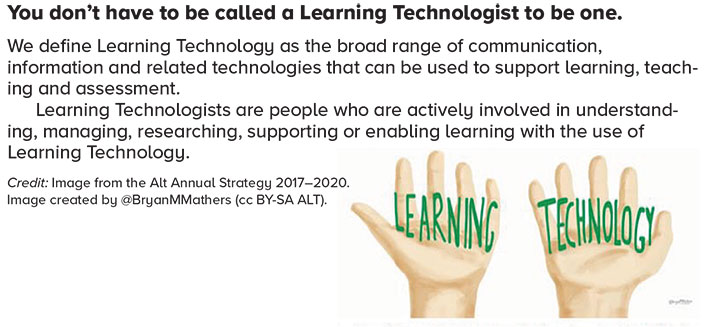
I'm proud to be a learning technologist, and I'd like to unpack a little of what that means to me and what has shaped my professional practice over the past decade—which in turn provides the foundation for the work I lead in the United Kingdom on a national scale to strengthen recognition and representation for learning technologists. Fundamental to my approach is that I strongly believe the intelligent use of learning technology can best be developed by working across higher education and can become an effective way for all to learn, teach, and assess—informed by open practice, innovative research, and global policy. I want to highlight ALT's values of openness, collaboration, participation, and independence, with our 3,500+ members at the heart of everything we do.
Being a learning technologist gives me the opportunity to think about some of today's most urgent questions. Technological innovation or disruption alone can't help us articulate answers to such questions. For example, as Audrey Watters explained in her annual review "The Stories We Were Told about Education Technology" or as Martin Weller wrote in his blog series "25 Years of Ed Tech": "Education is fundamentally a human enterprise."1 Thus, we must situate our use of technology and our relationship with it in the theoretical, historical, and critical frameworks from across disciplines.
Some might think that day-to-day activities such as designing modules in a learning management system (LMS), explaining how open licenses work, and training staff in the use of social media are far removed from the bigger issues surrounding privacy, automation, or the politics of innovation. Or some might think that since the majority of us work within systems, frameworks, and institutions, we are left with little freedom for addressing the bigger questions. Yet when we look at the factors that impact our day-to-day work, we can soon see how much of the work of learning technology, how much of our professional practice, happens right where we negotiate our relationship with technology. Let me share some examples.
Our Professional Practice
Take the value of labor, for instance. Last year, a new institutional policy for lecture recording was being developed at the University of Edinburgh. Melissa Highton, assistant principal and director of Learning, Teaching and Web Services (LTW) at the University of Edinburgh, blogged openly about the process. It started normally enough but then happened to coincide with industrial action at UK universities, and suddenly the questions about the new policy went from the topics of pedagogical approaches, attendance levels, and revision tools to such concerns as whether or not a university may use recorded lectures to "replace" teachers during strike action, enabling the institutions to continue with "delivering learning." As a leader in learning technology, Melissa reflected on the relationship between professional learning technologists and their academic colleagues:
What happens when things go wrong? How resilient is the relationship between edtech and educators when we are tested by strikes, snow and sedition? How do we best learn from critical incidents? Can breakdowns in trust be repaired? What will we do when it happens again?2
With input from all parties involved, the process resulted in a robust policy that was successfully adopted at the University of Edinburgh and now serves as a model not only for lecture-recording policies but also for practices to openly share the policy-making and consultation approach as well as the resources created for wider benefit. To me, this is a powerful example that learning technology is inherently political and that we need to be mindful of how our use of it shapes the value of labor.
Another example is an initiative, recently announced in the United Kingdom, that is focused on the prevention of student suicides. One of the projects includes an Early Alert Tool, led by Northumbria University, intended to "identify students at risk of mental health crisis by mining data sources, like social media."3 While well-intentioned, this and other national efforts to scale up the use of learning and learner analytics ask serious questions of us: they require us to articulate how we can make ethical use of such technology, what approaches we want to see adopted by policy makers, and how we can cooperate with each other and with industry to educate ourselves and our students. ALT consulted its membership and submitted a response to the UK's All-Party Parliamentary Group on Data Analytics. In this response, ALT focused on concerns regarding the legitimacy of education providers' decisions about individual students based on potentially biased and opaque algorithms and regarding the providers' ability to assess the validity of their decisions and to set out appropriate institutional policies for informed consent from all data subjects.4 We believe that learning technology professionals have an important role to play in advising policy makers, helping institutions develop informed and effective use of data and analytics, and supporting educators and learners to develop critical data literacy skills.
Of course, any one example can only scratch the surface of the scary realms in which some of the more sophisticated surveillance products are operating. As Martin Hawksey, chief innovation, community and technology officer for ALT, recently wrote: "We all know that technology is not neutral." In the case of face detection and recognition, however, "one of the biggest differences is where we 'choose' to share data on social media." Hawksey added: "We can be surveilled often without knowledge and increasingly without choice."5 This takes on even more significance when we consider the increasingly commonplace usage of such technologies in education for learners of all ages. We need to ask ourselves: how can we empower faculty and students alike in acquiring the data and digital literacy skills required to make informed decisions about using technology intelligently and responsibly and ethically?
In the February 2019 workshop "Human Transformation: Remembering and Learning" at the Royal Society, Diana Laurillard, Professor of Learning with Digital Technologies at the UCL Institute of Education, made a point that resonated with me. Speaking about the enormous scale of the demand for education (at all levels) worldwide, she reflected on how many hundreds of thousands of teachers will be needed to provide education and training as more learners, particularly in the Global South, gain access to education and come online. Technology properly and intelligently used, Laurillard argued eloquently, can help us to scale up provision and broaden access for all learners, especially those who may otherwise not find access.
But the teachers at the heart of that endeavour also need the requisite digital skills. Alongside the rest of the workforce, we in education face the huge challenge of continuously upskilling literally everyone to keep pace with change and innovation. And this is another context in which learning technologists face the sharp end of the adoption curve. We must keep a step ahead not only of staff and students, who need the right skills, but also of the decision makers, who negotiate contracts with suppliers and make decisions about what technology will be used. We must be able to advise them, help them ask the right questions, and provide an expert perspective situated within the learning context.
With only these few examples, we can begin to see the range of situations and contexts of professional practice in learning technology. But what are the competencies required for this practice, and how can learning technologists gain recognition for their work?
Peer Accreditation
ALT's work reaches back nearly three decades. In that time, we have seen learning technology change from a specialism adopted by individuals from different disciplines and backgrounds into a career path that attracts a growing number of professionals, from junior positions all the way to the most senior levels. For the past ten years, I have been leading the work at ALT to develop and enhance professional recognition in the United Kingdom. ALT's approach centers on four core principles of professional practice: (1) a commitment to communicate and disseminate best practice; (2) an empathy and willingness to learn from colleagues from different backgrounds and specialisms; (3) a commitment to keep up-to-date with new technologies; and (4) at the heart of it all, a commitment to exploring and understanding the interplay between technology and learning (see figure 2).
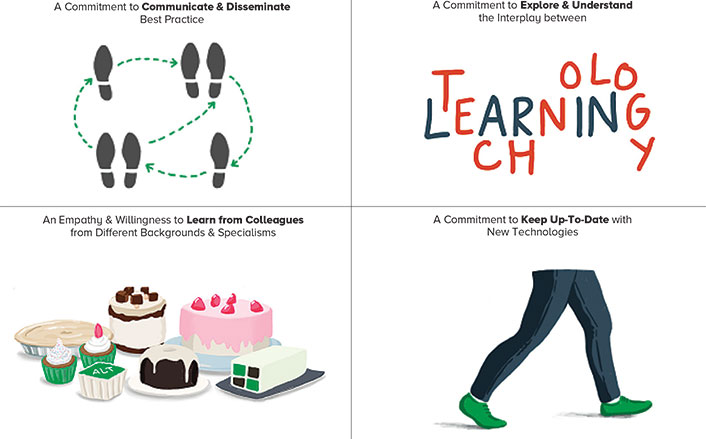
Figure 2. Four Core Principles of Professional Practice
Building on these four core principles is ALT's accreditation scheme, CMALT (Certified Member of ALT). This accreditation framework provides pathways to peer-assessed accreditation for learning technology professionals in the United Kingdom and internationally. It is intended for professionals who are actively involved in understanding, managing, researching, supporting, and/or enabling learning with the use of learning technology. Achieving "Certified Membership" status is recognition from your peers that you are a current practitioner.6
The existing framework has stood the test of time for over ten years and continues to be at the heart of what we do. However, we also know that the community we serve is growing and diversifying and that its needs are increasing. So this year we developed an expanded framework that provides two new pathways to accreditation: Associate CMALT and Senior CMALT. Figure 3 shows how we distinguish between the different pathways. Because we understand that there is a wide breadth of learning technology roles, we include differentiators such as years of experience, what the focus of a role may be, and how big an impact a role may have. For example, a growing number of ALT members have senior, management, or leadership roles; the Senior CMALT accreditation will offer a valuable pathway for them as they seek to progress from CMALT, or it can provide a stand-alone accreditation appropriate to their current role and requirements.
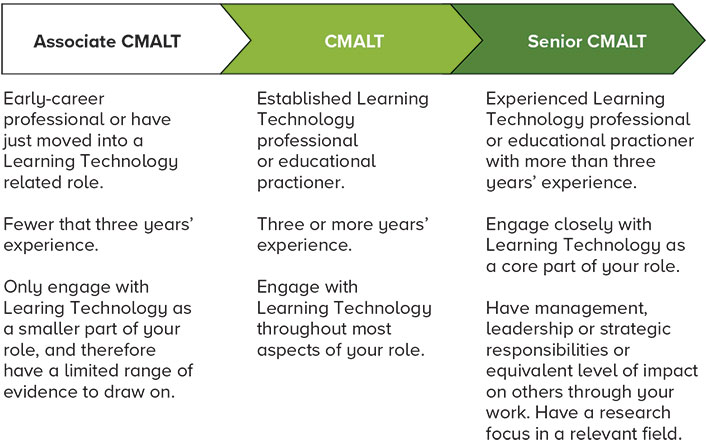
Figure 3. The CMALT Expanded Framework
The CMALT Accreditation Framework requires three elements in each section: description; evidence; and reflection (see figure 4). This sounds simple enough, but many professionals struggle to take credit for their work by saying: "I did this . . ." Similarly, reflecting on failures is a valuable but difficult undertaking. Very few learning technologists feel comfortable including examples of things that went wrong, although this is a perfectly valid way to demonstrate competence. It's a shame that this record of our professional practice doesn't often reflect the extent to which we need to take risks, experiment, and allow things to fail in order to succeed.
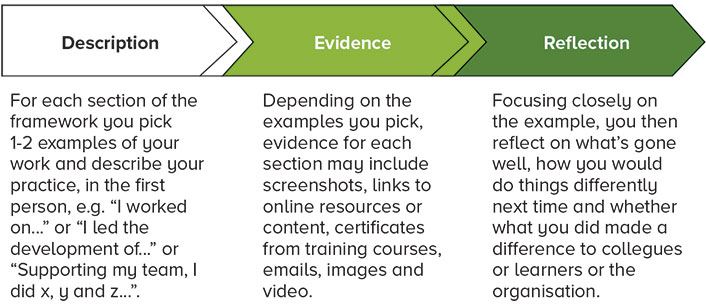
Figure 4. Core Elements of CMALT Accreditation
So, here is a quick preview of what the expanded framework looks like, starting with the four core competency areas required for everyone.
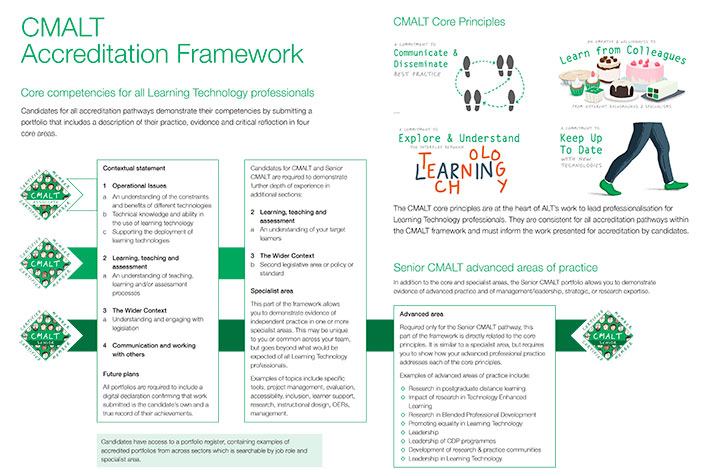
Finally, CMALT is based on peer assessment. Everyone who gains accreditation is strongly encouraged to become an assessor in turn. My own experience of this process has been very positive. Working alongside some accomplished lead assessors has become an important part of my professional development, challenging my understanding of practice. As the peer review gradually scales up year after year, it also provides a robust yet agile foundation that allows ALT to map the CMALT framework to a number of other competency frameworks.
Gender Equality
As a woman in a senior leadership role in learning technology, I am reminded, every day, that we still have a long way to go in achieving gender equality, especially considering the broader challenge of addressing the structural inequalities in our institutions, in national policies, and also, in an ever-more-connected world, on a global scale. I feel this has particular relevance for online and distance education. At the heart of our endeavour as professionals who work in educational technology should be to provide greater access to education for all, to create equity for all learners, and to learn how we can use technology, in an informed and reflective way, to help us achieve those aims.
When I started working as a learning technologist, I had no concept of how much inequality existed and how much it would affect every single day of my professional practice and that of every colleague, every learner. While my position is indeed one of relative privilege, it is nonetheless also an experience of inequality. As a learning technologist in a leadership position, I am sobered to see the structural inequality on a national and global scale. But while the bigger picture is important to my work, many examples of inequality can be found much closer to home, in the day-to-day working life: being the token woman on a "manel"; being the only woman on a table of policy makers representing "the sector"; not being allowed to ask questions at events; not being invited, not being funded, not being considered for an opportunity. As the list of examples goes on, I struggle to remain dispassionate.
Over the past seven years, I have worked hard to help address gender equality within the governance structure, professional recognition, and international events platform of my organization, and we can see real change there. Yet I hope to achieve more in promoting equality in learning technology. I leverage my voice, my professional standing, to make a difference, and I do my best to take every opportunity I can to do so. A recent example is a new report, based on data from ALT's annual survey, that explores how professional practice is developing from a gender perspective. This includes an analysis of professional roles by gender and also compares views on enablers and drivers in the use of learning technology. A core part of the survey, it is openly shared in the ALT Open Access Repository.
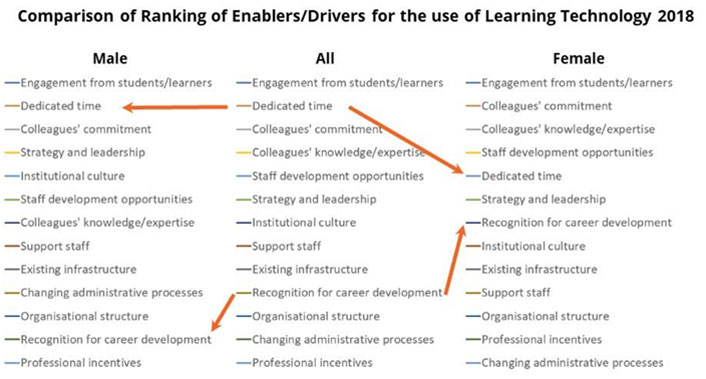
Yet while there is growing momentum behind addressing gender equality in the industry, others will ask: "So what?" For many learning technologists, gender equality doesn't have anything to do with them. It's not something they want me or people like me to go on and on about. The problem is that many do not realize this is not strictly a women's issue. Promoting equality is everyone's responsibility.
Our work as learning technologists can help. I want to recognize the work of so many others who give their time and energy in this endeavour:
- The Feminist Internet, which includes a partnership with the University of the Arts London (UAL) Creative Computing Institute (CCI) to design a feminist Alexa7
- The #femedtech network on Twitter (@femedtech), which set up an Open Space at the OER19 conference to explore feminist perspectives on open educational practice (contributions to which are still welcome)
- The Women in Red, who work to address the gender imbalance of English-language Wikipedia bios, of which only 17 percent are about women
- The UnCommon Women project (headed by Kelsey Merkley), which aims to "advocate, amplify, and support women"
Despite the progress we have made, we still have a long way to go when it comes to achieving gender equality. It is important to acknowledge that this goal is only a small part of the bigger set of challenges and a wider set of inequalities we need to address in our effort to make education more equitable for everyone.
Conclusion
This brings me back to the urgent need to tackle, with the help of learning technology, some of the biggest education challenges we face globally. That effort must be led by empowered professionals. It is tempting to wish for technology-led quick solutions instead of taking the time to invest in people. In the community I serve, however, we have come to recognize that in order to make real change happen, in order to shape the future of learning and teaching for the better, you can take no shortcuts. When it comes to finding the best ways to make use of technology in education, there is no substitute for human experience and expertise. A more reflective, more creative, more critical perspective will move us firmly beyond simple advocacy toward a more mature and impactful professional practice.
This article was adapted from my keynote presentation "You Are More Than a Data Point," ETUG 25th Anniversary Conference, Thomson Rivers University, Kamloops, British Columbia, June 21, 2019, and from my related blog post.
Notes
- Audrey Watters, "The Stories We Were Told about Education Technology," Hack Education (blog), December 18, 2018; Martin Weller, "25 Years of Ed Tech: Themes and Conclusions," The Ed Techie (blog), September 5, 2018. ↩
- "Dealing with Relationship Breakdowns," Melissa Highton (blog), August 14, 2018. ↩
- Eleanor Busby, "University Regulator Unveils £14M Mental Health Scheme to Reduce Student Suicides," The Independent, June 5, 2019. ↩
- Association for Learning Technology (ALT), "Response from ALT's Members: Technology and Data Ethics Inquiry," [January 2019]. ↩
- Martin Hawksey, "#Domains19: Minority Report—One Nation under CCTV," MASHe (blog), June 11, 2019. ↩
- My own CMALT portfolio is openly available. For more information, see also my blog, Maren Deepwell. ↩
- Marta Roncero, "Feminist Internet: Designing a Feminist Alexa," Medium, January 15, 2109. ↩
Maren Deepwell is Chief Executive of the Association for Learning Technology in the United Kingdom and also works as an anthropologist and open practitioner.
© 2019 Maren Deepwell. The text of this article is licensed under the Creative Commons Attribution 4.0 International License.
EDUCAUSE Review 54, no. 4 (Fall 2019)
